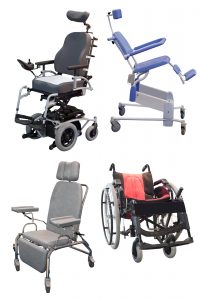To maintain a well supported seating position it is important that consideration is given to ensuring that all parts of the body are positioned appropriately. The aim of postural support for seating is to provide a stable base at the pelvis, ensure the person’s bottom is positioned as far back as possible in the chair. This will provide stability. Following this, other aspects of positioning should be addressed:
- Thighs should be parallel and supported along their entire length spreading the person’s weight over as wide an area as possible. Ideally, there should be a 90° angle at the hips between trunk and thighs.
- Feet should be supported along their entire length; this may mean some people require longer footplates if they are seated in a wheelchair. Good foot support will provide increased balance and stability which will impact upon the rest of the body. When using a wheelchair, it is important for safety reasons that feet are positioned correctly. A foot which is dangling off the footplate is vulnerable to injury, especially when the wheelchair is moved.

- Knees should be at a 90° angle and should be slightly apart, not touching. This will help prevent tightness of the muscles at the hip and thighs which, if not addressed may lead to shortening of the muscles and potentially painful contractures.
- The trunk (body) should be positioned so the person is sitting as straight as possible, not leaning to one side. The trunk should be well supported by a back rest. Additional lumbar support can be provided to help maintain the correct curvature of the spine: a lumbar roll or rolled up towel placed in the lumbar region, can help to maintain correct curvature of the spine.
- Upper Limbs need to be positioned at the correct height to support the joints. This may involve alterations to the height of arm rests, use of cushions and table tops.
- Once all other body parts are appropriately supported and positioned, consideration should be given to head control. The head is a very heavy part of the body yet is supported on a mobile cervical spine; therefore head control will only be adequately achieved if all the other body parts are adequately supported.
Specialist wheelchairs (e.g. tilt-in-space chairs) are available which provide the necessary support for the person with poor or no sitting balance. Pressure relieving cushions are a requirement for those with sensory impairments.
The person with postural and seating needs following brain injury will benefit from a referral to Occupational Therapy and/or Physiotherapy services. Local specialist seating services provide expert assessment, help and advice regarding provision of specialist wheelchairs, specialist static chairs and pressure cushions.
Please note that the person with impairments of balance and/or impaired sensation is more likely to need specialist equipment e.g. pressure relieving cushion and tilt-in-space chair.